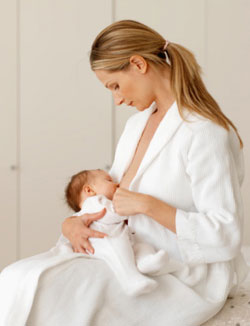|
|
Mastitis
 Mastitis is inflammation of tissue in one or both mammary glands inside the
breast. Mastitis usually affects
lactating women - women who are
breastfeeding,
producing milk. Hence, it is often referred to as lactation mastitis. The
patient feels a hard, sore spot inside the breast. Mastitis can occur as a
result of an infection or a blocked milk duct. Mastitis is inflammation of tissue in one or both mammary glands inside the
breast. Mastitis usually affects
lactating women - women who are
breastfeeding,
producing milk. Hence, it is often referred to as lactation mastitis. The
patient feels a hard, sore spot inside the breast. Mastitis can occur as a
result of an infection or a blocked milk duct.
Causes:
-
Mastitis (inflammation of breast tissue) is a common benign cause of a breast
mass. It is commonly seen in women after
childbirth while breastfeeding.
However, women with diabetes, chronic illness, AIDS, or an impaired
immune
system may be more susceptible to the development of mastitis.
-
About one to three percent of breastfeeding mothers develop mastitis, usually
within the first few weeks after
delivery. Most breast infections occur within
the first or second month after delivery or at the time of weaning.
-
The most common reason for this is a problem with the way your baby latches
on. If you and your baby haven't got the hang of latching on properly, milk
won't be removed efficiently. Other causes of mastitis include complications
during delivery and inability to breastfeed the baby soon after birth,
engorgement that doesn't return to normal, feeding to a strict routine, an ill
fitting bra, high level of maternal stress or fatigue or even trauma to the
breast, which can all cause milk stasis leading to mastitis.
Chronic mastitis occurs in women who are not breastfeeding. In postmenopausal
women, breast infections may be associated with chronic inflammation of the
ducts below the nipple. Hormonal changes in the body can cause the milk ducts to
become clogged with dead skin
cells and debris. These clogged ducts make the
breast more prone to bacterial infection. This type of infection tends to come
back after treatment with antibiotics.
Symptoms:
In the vast majority of cases only one breast is affected.
The following signs or symptoms, which may develop rapidly, could be present
(a symptom is something the patient feels or reports, while a sign is
something other people, including the doctor identify):
-
An area of the breast becomes red.
-
The affected area of the breast hurts when touched.
-
The affected area feels hot when touched.
-
A burning sensation in the breast which may be there all the time, or
only when breastfeeding.
-
Pus draining from the nipple.
-
Abscess: Sometimes a breast abscess can complicate mastitis.
 Harmless, noncancerous masses such as abscesses are more often tender and
frequently feel mobile beneath the skin. The edge of the mass is usually
regular and well defined. Harmless, noncancerous masses such as abscesses are more often tender and
frequently feel mobile beneath the skin. The edge of the mass is usually
regular and well defined.
Sometimes, the following symptoms may also be present:
-
Anxiety, feeling stressed
-
Chills
-
Elevated body temperature- Persistent fever and no improvement
of symptoms within 48-72 hours of treatment
-
Fatigue
-
General aches and pains
-
General feeling of malaise
-
Shivering
Treatment:
One of the best treatments for mastitis is continued breastfeeding to keep
the milk flowing and draining from the infected tissue � it is in fact, safe for
both moms and babies to continue breastfeeding even through an infection. Your
doctor will prescribe an antibiotic to treat the infection, and you should be
sure to take the entire prescription as directed.
Whether you start antibiotics immediately or decide to wait for 24 hours, you
can help yourself by trying the following:
-
 Make sure your baby is latched on properly at the breast and feeding well. Make sure your baby is latched on properly at the breast and feeding well.
-
Try different feeding positions if they help your baby to latch on better.
-
To keep the affected breast well drained, breastfeed as often as your baby
wants to.
-
Express milk by hand or with a pump, after feeds, if you feel your baby has
not used the breast well.
-
Some mothers find a breast pump removes milk better than their baby,
particularly if they also have sore nipples.
-
If you feel ill, rest as much as you can. It may be a good idea to let your
husband or a relative take care of your baby while you catch up on much needed
rest.
-
You may find that it helps to apply warmth to the affected area, such as a
warm compression, or have a warm bath or shower. Some mothers find that cold
compresses work better. And still others find that alternating between cool and
warm compressions stimulates the breast tissue well.
-
If it helps to
massage your breasts, do so very gently while your baby is
feeding to help the milk to flow from them. Vigorous massage can actually make
mastitis worse by pushing the "leaked" milk further into the breast tissue.
-
You can also take painkillers to help with the pain. Ibuprofen can be taken
whilst breastfeeding and may help to reduce inflammation as well as pain. Paracetamol is an alternative.
-
You may also consider homeopathic medications, such as Phytolacca and
Echinacea that are effective in treating mastitis. Do consult a homeopathic
specialist for appropriate dosage though.
Untreated cases of mastitis can result in a serious abscess which may need to
be treated with surgery to drain it. To avoid and treat mastitis, try to get
your infant on a schedule of breastfeeding � regularly emptying your breasts
will help maintain healthy breasts and a good supply of milk for your baby.
Prevention:
-
Allow your baby to completely empty one breast before switching to the
other breast during feeding. If your baby nurses only for a few minutes on the
second breast � or not at all � start breast-feeding on that breast the next
time you feed your baby.
-
Make sure your baby latches on properly during feedings.
-
Change the position you use to breast-feed from one feeding to the next.
-
Finally, don't let your baby use your breast as a pacifier. Babies enjoy
sucking and often find comfort in suckling at the breast even when they're not
hungry.
Related Links
|
|
|
|
|
 Harmless, noncancerous masses such as abscesses are more often tender and
frequently feel mobile beneath the skin. The edge of the mass is usually
regular and well defined.
Harmless, noncancerous masses such as abscesses are more often tender and
frequently feel mobile beneath the skin. The edge of the mass is usually
regular and well defined.

 Mastitis is inflammation of tissue in one or both mammary glands inside the
breast. Mastitis usually affects
Mastitis is inflammation of tissue in one or both mammary glands inside the
breast. Mastitis usually affects
 Make sure your baby is latched on properly at the breast and feeding well.
Make sure your baby is latched on properly at the breast and feeding well.
